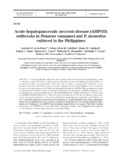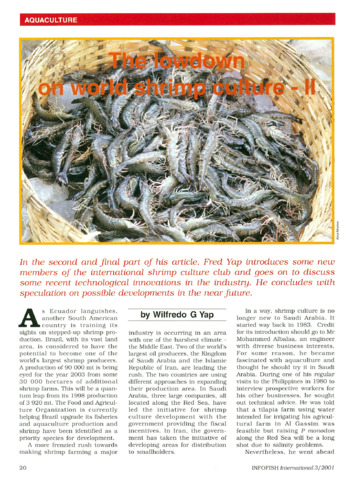Acute hepatopancreatic necrosis disease (AHPND) outbreaks in Penaeus vannamei and P. monodon cultured in the Philippines

Associated URL
www.int-res.comDate
2015Author
Page views
352Metadata
Show full item recordCited times in Scopus
Share
Abstract
Acute hepatopancreatic necrosis disease (AHPND) has recently emerged as a serious disease of cultured shrimp. It has also been described as early mortality syndrome (EMS) due to mass mortalities occurring within 20 to 30 d after stocking of ponds with postlarvae. Here, Penaeus vannamei and Penaeus monodon from shrimp farms in the Philippines were examined for the toxin-producing strain of Vibrio parahaemolyticus due to AHPND-like symptoms occurring in marketable size shrimp. In the P. vannamei, histology revealed typical AHPND pathology, such as sloughing of undifferentiated cells in the hepatopancreatic tubule epithelium. Analysis using the IQ2000 AHPND/EMS Toxin 1 PCR test generated 218 bp and 432 bp amplicons confirmative of the toxin-producing strain of V. parahaemolyticus among shrimp sampled from 8 of 9 ponds. In the P. monodon, histology revealed massive sloughing of undifferentiated cells of the hepatopancreatic tubule epithelium in the absence of basophilic bacterial cells. PCR testing generated the 2 amplicons confirmatory for AHPND among shrimp sampled from 5 of 7 ponds. This study confirms the presence of AHPND in P. vannamei and P. monodon farmed in the Philippines and suggests that the disease can also impact late-stage juvenile shrimp.
Suggested Citation
de la Peña, L. D., Cabillon, N. A. R., Catedral, D. D., Amar, E. C., Usero, R. C., Monotilla, W. D., Calpe, A. T., Fernandez, D. D., & Saloma, C. P. (2015). Acute hepatopancreatic necrosis disease (AHPND) outbreaks in Penaeus vannamei and P. monodon cultured in the Philippines. Diseases of Aquatic Organisms , 116(3), 251-254. https://doi.org/10.3354/dao02919
DOI
10.3354/dao02919Subject
Taxonomic term
Collections
- AQD Journal Articles [1240]
Related items
Showing items related by title, author, creator and subject.
-
An overview of the nutrition, feed and feeding techniques of prawn penaeid/shrimps
Piedad-Pascual, Felicitas (Philippine Council for Aquatic and Marine Research and Development, 1989)This paper echoes what transpired during the first International Conference of Penaeid Prawns/Shrimps held in Iloilo City in December 4-7, 1984, particularly on the Nutrition nd Feed Development. Around 25 papers were ... -
The lowdown on world shrimp culture - II
Yap, Wilfredo G. (INFOFISH, 2001)This paper introduces some new members of the international shrimp culture club and goes on to discuss some recent technological innovations in the industry, particularly the polyculture of tilapia (mainly Oreochromis ... -
Microbial diseases of prawns
Southeast Asian Fisheries Development Center, Aquaculture Department (Aquaculture Department, Southeast Asian Fisheries Development Center, 1988)





